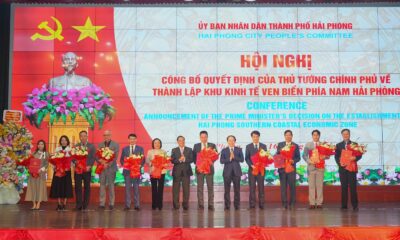Activities
Lạng Giang: Attracting Investment for Industrial Growth with a Green Urban Vision
Published
10 months agoon
Lạng Giang District is focusing on transforming into a green urban hub with a distinctive cultural identity and a key economic growth center in northern Bắc Giang Province. The district prioritizes clean, eco-friendly industries, economic restructuring, and enhancing investment efficiency in production.
Emerging Industrial Hub
According to planning strategies, Lạng Giang is poised to become Bắc Giang’s new industrial capital, hosting numerous industrial zones and clusters. Notable industrial parks include:
- Nghĩa Hưng (189 ha)
- Xuân Hương – Mỹ Thái – Tân Dĩnh (200 ha)
- Thái Đào – Tân An (130 ha)
- Mỹ Thái (160 ha)
- Tân Hưng (155 ha)
Nguyễn Văn Bằng, Chairman of the Lạng Giang People’s Committee, emphasized the district’s commitment to attracting investment through comprehensive strategies, including:
- Promoting a favorable investment environment
- Ensuring efficient land compensation and clearance
- Implementing transparent land use plans
- Hosting regular dialogues between local authorities and businesses to address concerns
In 2024, the district strictly adheres to Government Resolution 105/NQ-CP to support businesses by streamlining investment procedures and accelerating infrastructure development in industrial zones.
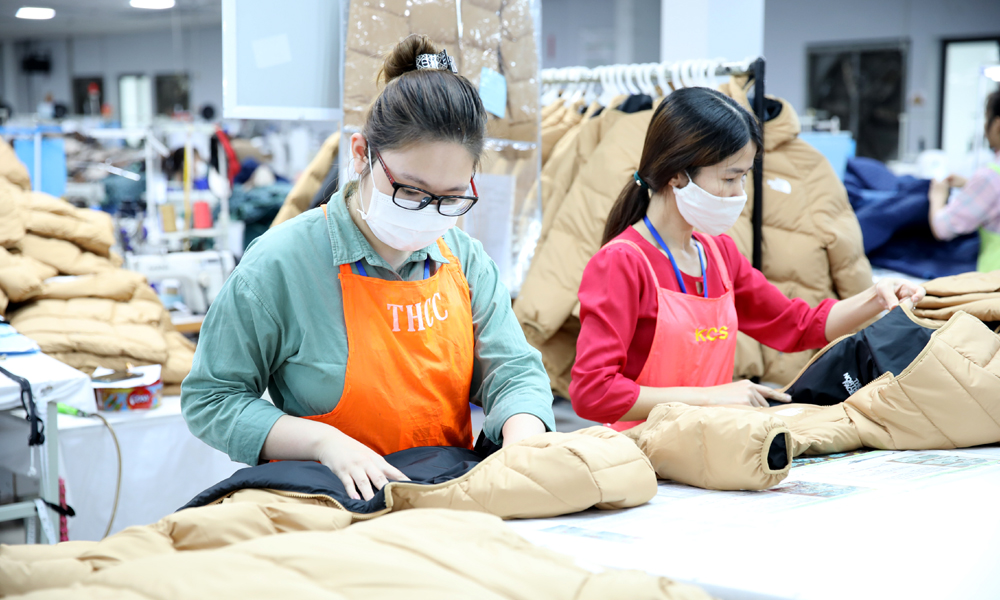
A prime example is Phuc Minh Huy Manufacturing & Trading Co., Ltd., located in Hương Lạc Commune. The company, with a 3,200 m² production facility employing 170 workers, specializes in assembling electronic components. HR Manager Nguyễn Thị Huệ shared, “Our Chinese investors chose Lạng Giang due to its excellent transportation links and business-friendly environment.”
Looking ahead to 2025, the district remains committed to resolving investment challenges, enhancing competitiveness, and attracting more investors, particularly in industrial parks and clusters. Approved projects are being closely monitored to ensure timely execution.
Developing a Green and Sustainable Urban Area
Under Bắc Giang Province’s master plan, Lạng Giang is designated as a northern economic hub, with Vôi Town as its central urban area, playing a crucial role in regional socio-economic development. Key urban development goals include:
- Expanding infrastructure and upgrading urban centers in Vôi and Kép to Class IV cities
- Establishing new Class V towns: Thái Đào, Tân Dĩnh, and Tân Hưng
- Transforming Lạng Giang into a green and eco-friendly city
To achieve these objectives, the district has outlined long-term and annual plans, allocating resources effectively. The total urban development budget from 2021 to 2025 is approximately VND 9,250 billion, sourced from provincial and district budgets, private investments, and other capital.
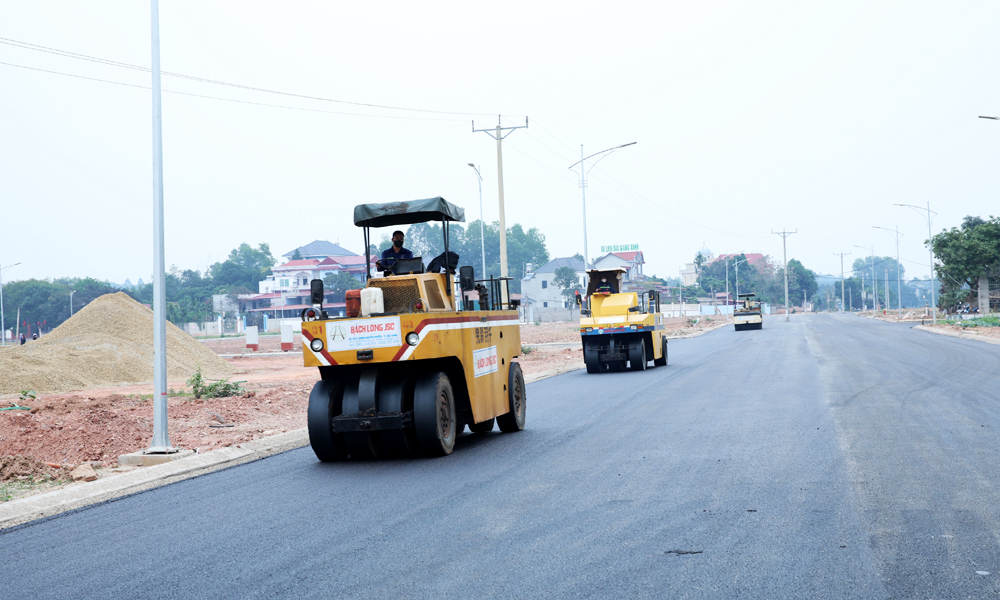
Vôi Town has mobilized over VND 300 billion and extensive community labor to develop modern infrastructure. Recent projects include:
- Upgrading main streets with improved lighting, sidewalks, and drainage systems
- Enhancing urban greenery and beautifying key intersections
- Renovating Victory Monument Square in Kép Town
- Installing street name signs and house numbering systems
On December 27, 2024, the Ministry of Construction officially recognized Vôi as a Class IV urban area.
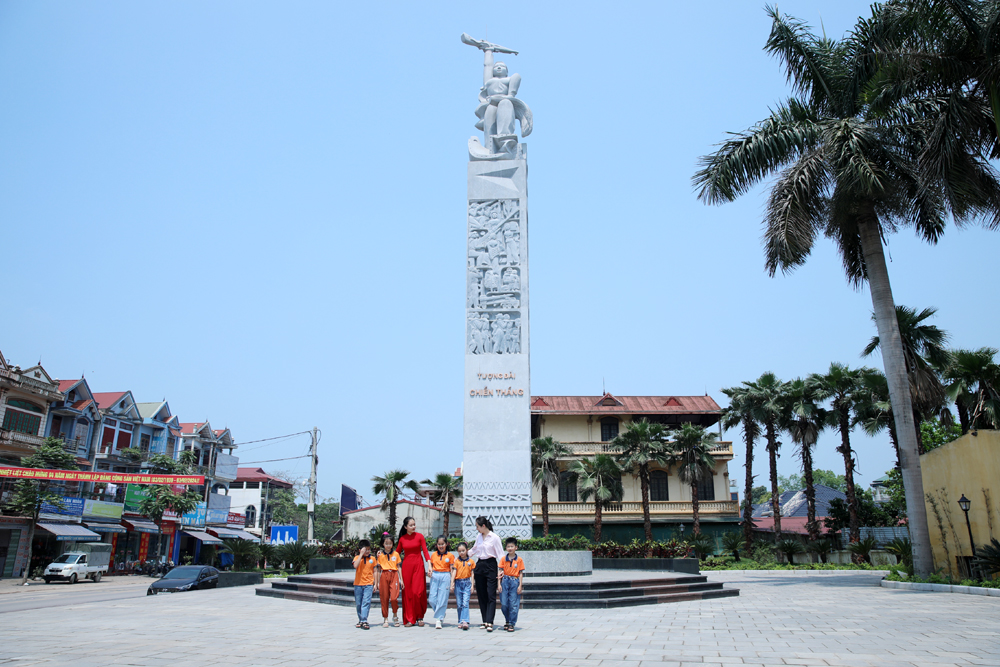
Lạng Giang continues prioritizing urban beautification projects. In 2024, major initiatives included:
- Paving sidewalks and enhancing streetscapes in Đông Vôi and Tây Vôi urban areas
- Developing landmark traffic intersections
- Revitalizing key public spaces
Economic & Infrastructure Department Head Tạ Ngọc Đông stated that by 2035, Vôi Town’s urban area will expand, integrating nearby communes into six designated development zones. For 2024-2025, the district focuses on:
- Constructing key infrastructure projects
- Attracting investments in urban residential and commercial projects
- Enhancing green spaces to modernize the district’s urban landscape
With these strategic efforts, Lạng Giang is on track to becoming a dynamic industrial and eco-friendly urban hub.
Activities
HoREA Proposes Allowing Businesses to Build Worker Housing Inside Industrial Parks
Published
8 months agoon
March 31, 2025The Ho Chi Minh City Real Estate Association (HoREA) has proposed a pilot mechanism that would allow businesses to invest in and construct worker housing within industrial parks.
In a document submitted to the Prime Minister, contributing feedback on a draft pilot policy aimed at boosting social housing development, HoREA suggested that businesses, cooperatives, and cooperative unions operating within industrial parks be permitted to build accommodation for their workers. It also called for allowing companies to rent housing outside industrial parks for the same purpose.
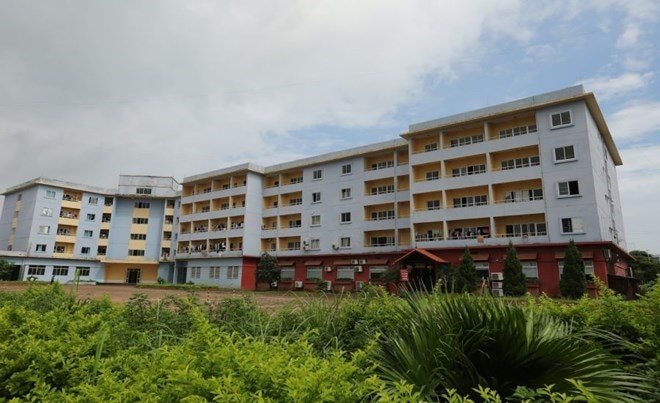
HoREA emphasized that all costs related to building or renting worker housing should be recognized as legitimate business expenses and be included in the enterprise’s operating costs.
The association further recommended expanding the policy framework to allow companies within industrial parks to lease social housing or worker accommodation built by third-party developers outside the park premises.
According to Mr. Lê Hoàng Châu, Chairman of HoREA, the current Housing Law (2023) only allows companies to rent worker housing inside industrial parks, without clearly defining whether they can rent social housing outside the parks or construct such housing themselves.
With worker housing demand at industrial parks far exceeding supply, HoREA pointed out that current social housing and dormitory offerings are inadequate. Meanwhile, commercial housing remains out of reach for most workers due to high prices. Therefore, the association urges the government to introduce policies enabling manufacturing businesses—despite not operating in real estate—to develop their own accommodation solutions for employees.
HoREA underscored that such policies would create a strong legal foundation, empowering enterprises and cooperatives to proactively resolve housing issues for workers. If allowed to construct their own housing, companies could ensure homes go to those in need, boosting employee retention, improving living standards, and supporting sustainable growth in industrial zones.
The association also proposed financial support mechanisms, including tax incentives, access to preferential loans, or government-matching support, to reduce the financial burden on companies participating in worker housing development.
Previously, many businesses had expressed a desire to buy land, build housing, and offer installment-based homeownership plans to workers, whereby employees would pay monthly through salary deductions. While this model helps workers secure long-term housing, legal procedures remain a major hurdle.
Providing accommodation has increasingly become part of corporate strategies to retain labor, alongside other employee welfare policies. For example, Nissei Electric Vietnam (Linh Trung 1 Export Processing Zone, Thu Duc City) has built a dormitory complex with 285 shared rooms, housing up to 2,280 workers. Eternal Prowess Vietnam (District 12) and Thien Phat Company (Linh Trung 2 EPZ) have also invested in on-site worker housing. Thien Phat’s project includes 368 units (35m² each), rented at VND 2.2 million/month, with 80% of the units for families and 20% for shared accommodations.
As of Q2 2024, Ho Chi Minh City has 18 industrial parks with around 1,700 businesses employing approximately 320,000 workers. Citywide, over 1.3 million people are employed in factories. However, there are only 16 official worker housing complexes, accommodating about 22,000 people. The majority of workers rely on rented rooms or stay with acquaintances—often sharing 12m² rooms among 2–3 people, which consumes 15–20% of their monthly income.
From 2021 to the present, Ho Chi Minh City has completed six social housing projects with 2,700 units and is building four more with 3,000 units. By April 30, the city aims to resolve legal hurdles and break ground on 5–6 additional social housing projects, totaling around 8,000 units.
Activities
Vietnam’s leading developer Becamex IDC targets $825 mln from ‘historic’ share offering
Published
10 months agoon
February 11, 2025Becamex IDC Corp, a leading eco-industrial and urban real estate developer in Vietnam, plans to raise nearly VND20.88 trillion ($825 million) from a public offering of 300 million shares on the Ho Chi Minh Stock Exchange (HoSE), equivalent to its current equity.
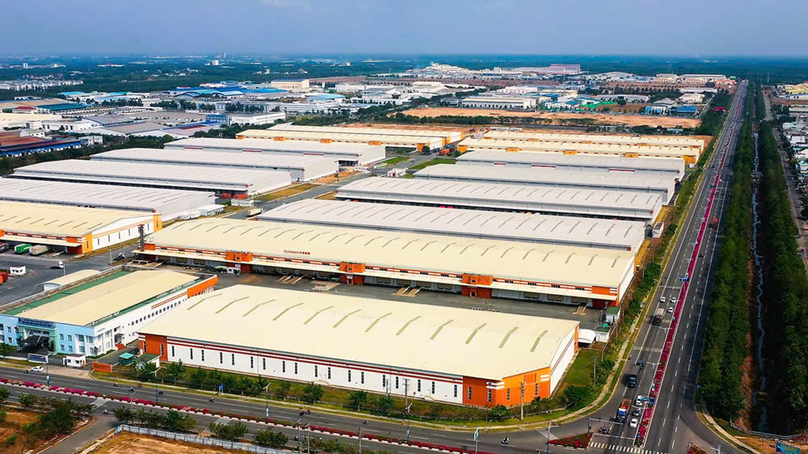
An industrial park developed by Becamex IDC. Photo courtesy of the company.
The corporation has approved the starting price of VND69,593 ($2.75) for the public auction of its BCM shares on the HoSE, aiming for VND20.88 trillion, nearly 40% higher than the initial expected value.
This offering is considered the largest since the state-owned capital divestment boom from 2016 to 2018.
The offering price is almost five times the book value of the stock at the consolidated financial statement for Q4/2024 and the average of the last 30 trading sessions prior to February 6, 2025 on the HoSE.
At the end of 2024, the company’s charter capital was VND10.35 trillion ($408.93 million), and equity was VND20.48 trillion ($809.2 million). If the capital raising is successful, its charter capital will increase to VND13.35 trillion, and equity will double to over VND41 trillion.
Becamex IDC, a giant in the industrial real estate sector in the southern province of Binh Duong, seeks to raise funds to invest in projects such as the Cay Truong Industrial Park and the expanded Bau Bang Industrial Park, as well as to contribute capital to existing companies, including Vietnam-Singapore Industrial Park J.V. Co. Ltd. (VSIP), Becamex Binh Phuoc Infrastructure Development JSC, Becamex VSIP Power Investment and Development JSC (BVP), Vietnam-Singapore Smart Energy Solutions JSC (VSSES), and Becamex Binh Dinh JSC. It also plans to restructure its finances.
Currently, the largest shareholder of the company is the People’s Committee of Binh Duong province, with a 95.44% stake. If the auction is successful, the state’s ownership will drop to 74%.
In the stock market, BCM moved counter to the VN-Index, steadily declining from VND87,000 ($3.44) per share at the end of 2022 to VND51,000 per share in April 2024. However, while the VN-Index stagnated, the ticker rebounded and closed at VND70,000 per share on Friday, up 37.2%.
The stock’s growth momentum slowed in the last quarter of the previous year due to a decline in business results. Specifically, in Q4/2024, Becamex IDC reported a sharp 60% decrease in revenue to VND2 trillion ($79 million).
Despite joint venture activities doubling profits to VND1.19 trillion, its after-tax profit still decreased by 33% to VND1.37 trillion ($54.13 million). For the whole year, its net revenue fell by 35% to VND5.2 trillion, and net profit dropped 12.5% to VND2.1 trillion.
Expansion ambition from 2024 to 2028
The corporation mainly operates in the fields of industrial park infrastructure investment, urban development, services, and trade. It is the developer of six industrial parks in Binh Duong province, covering a total land area of 2,931 hectares with an occupancy rate of 88%. The firm is also finalizing legal procedures to put the 700-hectare Cay Truong Industrial Park into operation in 2025.
In addition, Becamex IDC has expanded its reach to other localities outside Binh Duong, such as Binh Phuoc, Tay Ninh, Khanh Hoa, Quang Ngai, Thua Thien-Hue, Thanh Hoa, Nam Dinh, Ninh Binh and Hai Duong provinces, and Hai Phong city. The firm has also received in-principle approvals for four more industrial parks in Lang Son, Thai Binh, Binh Thuan, and Ha Tinh provinces.
Besides industrial parks, Becamex IDC has also developed urban and service areas such as the My Phuoc Residential Area, Thoi Hoa Residential Area, and Bau Bang Residential Area. The corporation plans to allocate resources for high-impact commercial projects like the WTC Exhibition Center, WTC Tower, and WTC Gateway cultural-central station complex in New Binh Duong town.
Moreover, the company, together with Singapore’s Sembcorp Industries, has developed the Vietnam-Singapore Industrial Park (VSIP) model, featuring an innovation center in an industrial-urban-service complex including a business incubator, advanced manufacturing center, and renewable energy research center.
These strategies will be implemented from 2024 to 2028, with a vision towards 2030. To achieve these goals, the company plans to increase its charter capital if necessary, borrow from credit institutions, and issue bonds.
Becamex IDC currently has total liabilities of VND38.3 trillion ($1.51 billion), with short-term debt of VND7.9 trillion and long-term debt of VND15.72 trillion. Its debt-to-equity ratio is 1.1 times.
Activities
Japan-invested solar cell maker Vietnam Sunergy to start $30 mln plant from June
Published
10 months agoon
February 11, 2025Japan-invested Vietnam Sunergy Wafer, a manufacturer of solar cells, plans to start official production at its $30 million factory in Hung Yen province from June.
The firm aims to complete administrative procedures in May and then install equipment in June, according to a recent project report. The plant covers 2.65 hectares in Minh Quang Industrial Park of the northern province.
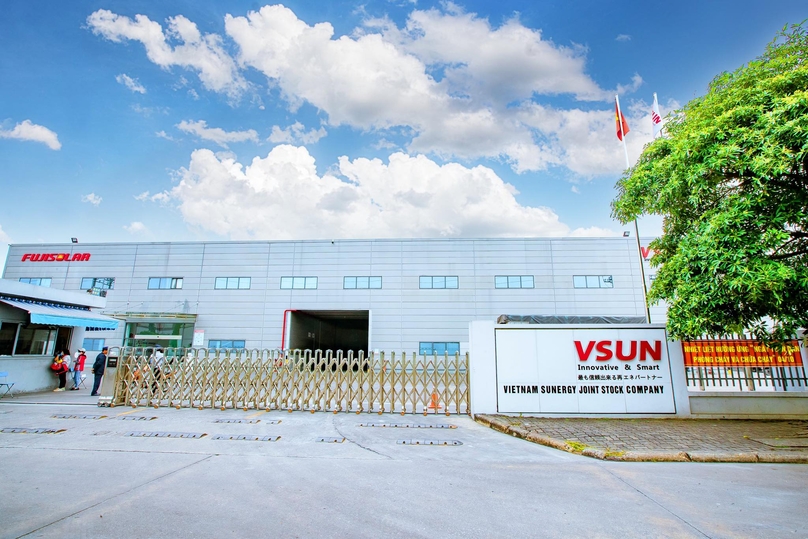
A factory of Vietnam Sunergy JSC. Photo courtesy of VSUN Solar Vietnam.
The project has an annual capacity of 600 million silicon wafers, a component of solar cells, equivalent to 9,375 tons. It is set to employ 1,000 people.
Hung Yen recorded registered foreign direct investment (FDI) of $1.5 billion in 71 projects in 2024, the highest-ever figure in terms of capital, according to provincial data.
The province, a neighbor of Hanoi, has so far attracted FDI of $8.5 billion. It now has 17 industrial parks in its masterplan, covering 4,395 hectares. Of these, 10 facilities are now operational.

Bac Giang International Logistics Centre launched

Vietnam’s Exclusive Economic Zone boasts over 1,000 GW of wind power potential: report

Uncertainty weighing on real estate

Central Vietnam city seeks $1.84 bln for 15 projects in economic zone


